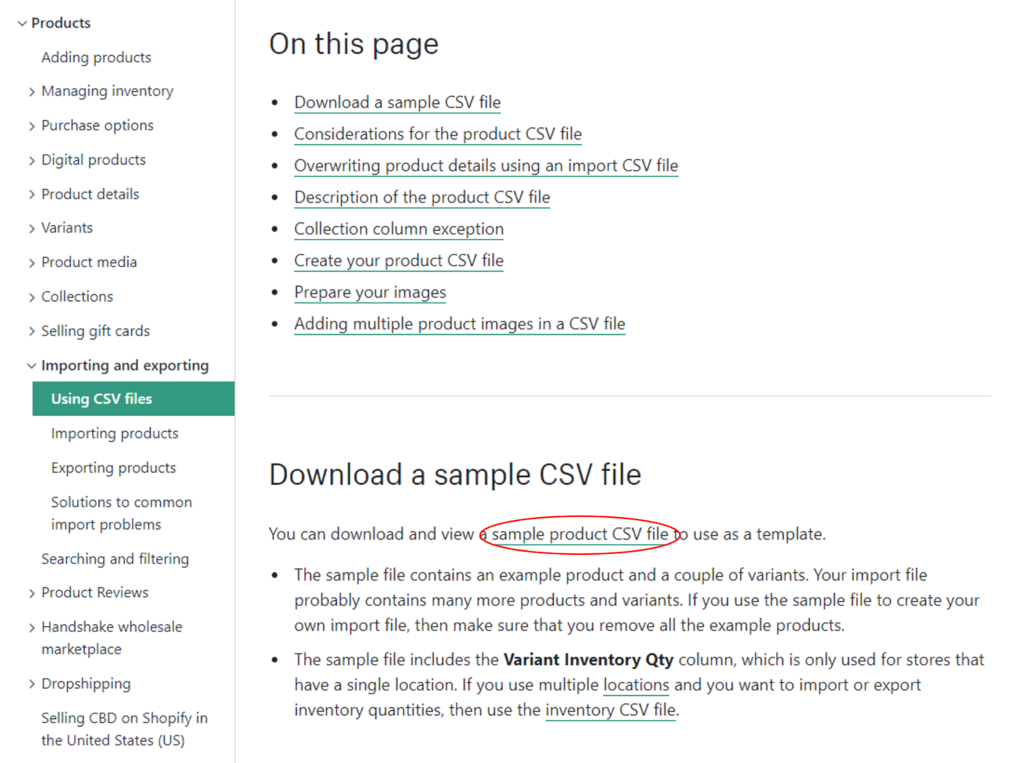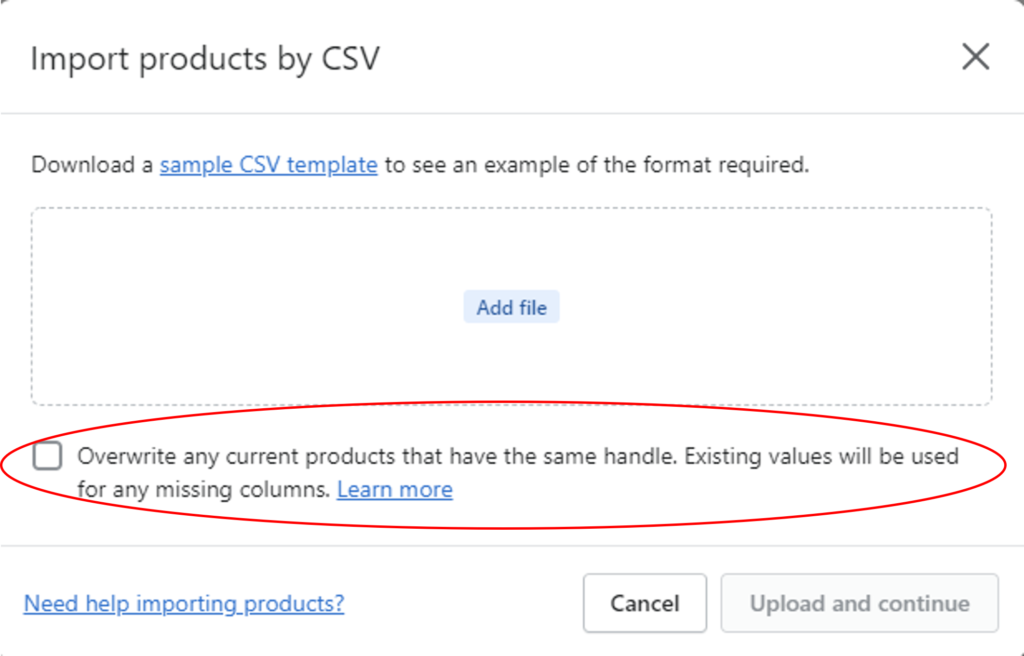More and more people worldwide are using Shopify to build their own e-commerce store.
The main attraction of Shopify is that many designs and functions can be implemented with no code using standard functions and extended applications; however, many people may be concerned about the capability to handle product registration, order data, etc. with CSV.
Also, even if you are already running an online store on Shopify, you may be troubled by the enormous amount of time it takes to register the products.
To solve the above concerns, this article introduces a method of batch upload of product data using CSV for such people.
This article is recommended for those;
- who are planning to set up an e-commerce site on Shopify
- who want to register products using CSV in Shopify
- who want to know how to create a CSV file for product registration for Shopify
Can we register product data in bulk via CSV in Shopify?
Shopify supports product registration using CSV.
In addition to product data, various data such as customer data, order data, deposit/withdrawal data, etc. can be imported/exported in CSV format.
In the following sections, we will thoroughly explain how to register product data in bulk using CSV.
How to import/export product data
First, we will explain how to import (upload) and export (download) product data on Shopify. The steps are as follows
- Open the Shopify administration page and click on “Products” on the left side of the screen. (circled in red in the image)
- Click “Export” or “Import” in the upper right corner of the screen. (Blue circle in the image)
Note: If you want to update only the inventory quantity, you can click on “Inventory” directly under Products and import/export from the button that appears. However, you do not need to use this feature for the following reasons:
- Stock quantity can also be updated in the CSV file exported/imported from Products following the above procedure.
- CSV file for inventory has a different data format, so it is necessary to prepare it separately from the product data CSV file.

How to create data for product registration by CSV
From here, we will explain how to upload a file created in CSV on Shopify’s server to register, update, and edit products in bulk. First, a format must be prepared, which can be done in one of two ways below:
- If you have already registered at least one product, No.1 would be easier to understand.
- If you have not yet registered any product, No.2 would be better.
Note: Shopify’s CSV has a slightly complicated data structure when there are multiple variations (different sizes, colors, patterns, etc.) for a single item. If you want to register multiple variations, we recommend that you export the sample product data with multiple variations from the admin page, and then use it as a reference to create the data.
Tips: How to register products with multiple variations
In Shopify’s CSV format, if a product has multiple variations, add a line with the same handle entered for each variation. Common fields associated with the parent product, such as Title and Body, need not be entered on each variation line. Enter only the options required for each variation, such as size name and color name. Also, add a line with the same handle to register multiple images in CSV.
<Example>
| Handle | Title | … | Option1 Name | Option1 Value | …. | Image Src | Image Position | … |
| sample-tshirt | Sample T-shirts | ~ | Color | Red | ~ | https:cdn.shopify.com/……..a.jpg | 1 | ~ |
| sample-tshirt | ~ | Blue | ~ | https:cdn.shopify.com/……..b.jpg | 2 | ~ | ||
| sample-tshirt | ~ | Blue | ~ | https:cdn.shopify.com/……..c.jpg | 3 | ~ | ||
| sample-tshirt | ~ | ~ | https:cdn.shopify.com/……..d.jpg | 4 | ~ |
1. Export existing data
Export existing product data using the method described above, and then edit the file.
2. Download the sample CSV file
Download the sample product CSV file from the Shopify official help page. However, if you use it as is, the sample products will be registered as well. So please delete the second line and below.
Link to download the smaple CSV file: https://help.shopify.com/en/manual/products/import-export/using-csv
↓Click on the red circle in the image to start downloading.

Columns in the product CSV file
Now that the product CSV file format is ready, the next step is to explain each item in detail. The author has added the column of “explanation” to a table in the official Shopify help. Please refer to the table below to accurately register your product data.
| Column No. in Excel | Column | Description (Refer to the official Shopify help) | Explanation (Added by Marketdive) |
|---|---|---|---|
| A | Handle | Handles are unique names for each product. They can contain letters, dashes, and numbers, but no spaces, accents, or other characters, including periods. Handles are used in the URL for each product.For example, the handle for a “Women’s Snowboard” should be womens-snowboard, and the product’s URL would be https://yourstore.myshopify.com/products/womens-snowboard.Every line in the CSV file that starts with a different handle is treated as a new product. To add multiple images to a product, you must add multiple lines with the same handle. | This item becomes the master of the product data CSV and is used as the URL. It is recommended that only one-byte alphanumeric characters and one-byte symbols be used. |
| B | Title | The title of your product. For example, Women's Snowboard. | This item is treated as the “product name” (title). This item is displayed on the product list screen and at the top of the product page. |
| C | Body (HTML) | The description of the product in HTML format.Learn more about how overwriting existing products affects the data in this column. | This is the product description. Since HTML can be written, images and links can also be inserted. However, be careful because even if there is a line break in the Excel file, it will not be reflected. You can insert a line break by writing at the end of the sentence where you want to break the line. |
| D | Vendor | The name of the vendor for your product. For example, John's Apparel.Values must be at least two characters long.Learn more about how overwriting existing products affects the data in this column. | – |
| E | Standardized product type | A label that describes the type of product. This label must be taken from the predefined standardized list of product types.You can input the standardized product type in either of the following ways:using the full path from the Shopify Product Taxonomy, for example Home & Garden > Linens & Bedding > Bedding > Bed Sheetsusing the numerical ID, for example 371Learn more about adding a standardized product typeLearn more about how overwriting existing products affects the data in this column. | Enter the Shopify-defined product type. Entering this will be used to create your collection. It is recommended that you set this up correctly, as it will also facilitate the delivery of free slots for Google Shopping Ads. |
| F | Custom product type | A custom label that describes the category of a product. This label doesn’t need to conform to any predefined format.Learn more about adding a custom product typeLearn more about how overwriting existing products affects the data in this column. | – |
| G | Tags | A comma-separated list of tags used to tag the product. Most spreadsheet applications automatically add quotes around the tags for you. If you use a plain text editor, then you need to manually add the quotes. For example, "tag1, tag2, tag3".Learn more about how overwriting existing products affects the data in this column. | This tag item can be used to create collections and implement a refinement feature on the product listing page. |
| H | Published | Indicates whether a product is published on your online store. Valid values are TRUE if the product is published on your online store, or FALSE if the product is not available on your online store. | – |
| I | Option1 Name | If a product has an option, then enter its name. For example, Color.If a product has only one option, then this value should be Title. | Used when there are multiple variations of a single part number. Example: “color”, “size”, etc. |
| J | Option1 Value | Caution: Changing data in this column deletes existing variant IDs values, and creates new variant IDs. Any change to variant ID values can break third-party dependencies on variant IDs.If a product has an option, then enter its value. For example, Black.If a product has only one option, then this value should be Default Title. | Used when there are multiple variations of a single part number. Example: “Blue”, “Size M”, etc. |
| K | Option2 Name | If a product has a second option, then enter its name. For example, Size.Learn more about how overwriting existing products affects the data in this column. | Use if there is more than one option. If not, leave blank. |
| L | Option2 Value | Caution: Changing data in this column deletes existing variant IDs values, and creates new variant IDs. Any change to variant ID values can break third-party dependencies on variant IDs.If a product has a second option, then enter its value. For example, Large.Learn more about how overwriting existing products affects the data in this column. | Ditto |
| M | Option3 Name | If a product has a third option, then enter its name.Learn more about how overwriting existing products affects the data in this column. | Ditto |
| N | Option3 Value | Caution: Changing data in this column deletes existing variant IDs values, and creates new variant IDs. Any change to variant ID values can break third-party dependencies on variant IDs.If a product has a third option, then enter its value.Learn more about how overwriting existing products affects the data in this column. | Ditto |
| O | Variant SKU | The SKU of the product or variant. This is used to track inventory with inventory tracking services.This field can’t be left blank if you’re using a custom fulfillment service .Learn more about how overwriting existing products affects the data in this column. | SKU name can be set for each item. Example: “Original-Tshirt-red-M” etc. |
| P | Variant Grams | The weight of the product or variant in grams. Don’t specify a unit of measurement or use decimals. For example, for a weight of 5.125 kg, enter 5125.Shopify always imports and exports the weight in grams, even if you specify a different unit. You must use accurate weights if you intend to offer carrier-calculated shipping or use a third-party fulfillment service. | Enter the weight of each option; for 999g, enter 999. You may leave this field blank. This field is required only if the shipping cost is set according to weight. |
| Q | Variant Inventory Tracker | Include your inventory tracking for this variant or product. Valid values include shopify, shipwire, amazon_marketplace_web, or blank if inventory isn’t tracked.If the existing inventory tracking options are removed, then inventory is no longer tracked.Learn more about how overwriting existing products affects the data in this column. | – |
| R | Variant Inventory Qty | The number of items you have in stock of this product or variant. This column is only used for Shopify stores that have a single location.Note: This column is only available for stores that have only one location. If your store manages inventory at multiple locations, then this column isn’t included. If you want to import or export inventory quantities, then use the inventory CSV file.Learn more about how overwriting existing products affects the data in this column. | – |
| S | Variant Inventory Policy | How to handle orders when the inventory level for this product or variant has reached zero. Variants with a deny inventory policy can’t be purchased after their inventory level reaches zero. Variants with a continue inventory policy can be purchased after their inventory level reaches zero, allowing for negative inventory levels. | – |
| T | Variant Fulfillment Service | The product or variant fulfillment service used. The following are the valid values for this column:manualshipwirewebgistixamazon_marketplace_webIf you use a custom fulfillment service, then you can add the name of the service in this column. For the custom name, use only lowercase letters. Spaces aren’t allowed and you must replace them with a dash (-). Periods and other special characters are removed. For example, if “Joan’s Fulfillment” is your fulfillment service’s name, enter joans-fulfillment in the CSV file.You must have a custom fulfillment service set up in your Shopify admin before you can add the name of the service in this column. | This is used when delivery is outsourced to a 3PL or other company. Enter “manual” if you are doing your own delivery. If you outsource shipping, go to “Settings” > “Shipping & Delivery” > “Custom Order Fulfillment” on the Administration page. |
| U | Variant Price | The price of the product or variant. Only include the price and don’t include any currency symbols. For example, 9.99. | Enter the product price. If you are having a sale (discount), enter the sale price. |
| V | Variant Compare at Price | The “Compare at Price” of the product or variant. Only include the price and don’t include any currency symbols. For example, 9.99.Learn more about how overwriting existing products affects the data in this column. | If you are having a sale, enter the pre-sale price. |
| X | Variant Requires Shipping | The option to require shipping. Valid values are TRUE or FALSE. | Enter TRUE or FALSE. |
| Y | Variant Taxable | Apply taxes to this variant. Valid values are TRUE or FALSE. | – |
| Y | Variant Barcode | The barcode, ISBN, or UPC of the product.Learn more about how overwriting existing products affects the data in this column. | – |
| Z | Image Src | Enter the URL for the product image. Shopify downloads the images during the import and re-uploads them into your store. These images aren’t variant-specific. The variant image column is where you specify variant images.You can’t change the image file name after that image has been uploaded to your store. Don’t upload images that have _thumb, _small, or _medium suffixes in their names.Learn more about how overwriting existing products affects the data in this column. | Enter the URL of the product image. Product images can be registered (1) directly to each product from the administration screen or (2) as a batch in a file. |
| AA | Image Position | Enter the number that represents the order in which you want the image to appear on the product’s page. The images appears in order from smallest to largest starting from an image position value of 1. For example, if you want the image to appear first for that product, then enter 1.Learn more about how overwriting existing products affects the data in this column. | Enter how many of the images entered in column Z will be displayed as product images. |
| AB | Image Alt Text | Alt (alternate) text describes an image and is an important part of a product description. If an image can’t load for any reason, then alt text is shown instead. It’s also used by assistive technology to describe an image to a customer who’s visually impaired. Including alt text will boost your website’s SEO. Keep your alt text brief and descriptive. The maximum length is 512 characters, but the optimal length is 125 characters or fewer.Learn more about how overwriting existing products affects the data in this column. | Enter the alt text for the image entered in column Z. |
| AC | Gift Card | Indicates whether the product is a gift card. Valid values are TRUE or FALSE. The addition of this column also allows you to edit other gift card details, such as the Body or Tags columns, and then import these changes. A gift card can only be created and activated in the Shopify admin. You can’t create a gift card through a product CSV file import.Learn more about how overwriting existing products affects the data in this column. | – |
| AD | SEO Title | The SEO Title is found on a product’s details page under the Search engine listing preview header in the Page title field. The SEO Title is alphanumeric and can include up to 70 characters. If you leave this column blank when you import a product, then the value in the Title column is entered into the Page title field on the product’s details page.Learn more about how overwriting existing products affects the data in this column. | Enter the SEO title. This is the title that will appear in the search results. |
| AE | SEO Description | The SEO description is also found on a product’s details page under the Search engine listing preview header in the Description. The SEO description is alphanumeric and can include up to 320 characters. If you leave this column blank when you import a product, then the value in the Body (HTML) column is entered into the Description field on the product’s details page.Learn more about how overwriting existing products affects the data in this column. | Enter your SEO description. This is the description that will appear in the search results. |
| AF | Google Product Category | If you currently use a Google product category, you can use it as your Shopify standardized product type. You can use the standardized product type, the Google Product Category, or both. Provide the most specific category possible for each item.The Google Product Category (GPC) (google_product_category) uses Google’s product taxonomy.You can input the Google product category in either of the following ways:using the full taxonomy path, for example Apparel & Accessories > Clothing > Shirts & Topsusing the numerical ID, for example 212Learn more about how overwriting existing products affects the data in this column. | Enter the Google Shopping product category. It is recommended that you enter this for all products, as it will increase your chances of being displayed in the free shopping ad space. See for supported values, including the name of each category. |
| AG~AR | Google Shopping Metafields | The Google Shopping columns might be used by an app to synchronize products to the Google Merchant Center. However, Shopify’s Google channel doesn’t use these Metafields. You can ignore values in the columns that include Google Shopping in their names unless an app tells you to use them.Learn more about how overwriting existing products affects the data in this column. | Enter the metafiels in each column for Google Shopping. |
| AS | Variant Image | The URL for images of variants. If you add an URL, then it must be a functioning image URL.Learn more about how overwriting existing products affects the data in this column. | – |
| AT | Variant Weight Unit | Valid values are g, kg, lb, and oz. | – |
| AU | Variant Tax Code | Available to: Shopify Plus planThe Avalara code to apply taxes to this product. This field only applies when you import to or export from a store that uses the Shopify Plus plan’s integration with Avalara AvaTax.When you create a CSV file by exporting products from a store that uses Avalara, the Variant Tax Code column is filled. If you import this CSV file into a store that doesn’t have Avalara set up, then your import fails.Learn more about how overwriting existing products affects the data in this column. | – |
| AV | Cost per item | How much it costs you for the product or variant. Only include the cost. Don’t include any currency symbols. For example, 9.99.Learn more about how overwriting existing products affects the data in this column. | – |
| AW | Status | Indicates whether a product is available to your customers. Valid values are:active: the product is active and ready to be solddraft: the product is a draft and needs to be completedarchived: the product is archived and no longer available to sell | “active” for public “draft” for drafts “archive” for archive |
Required fields in the product CSV file
Following fields musct be filled in the product CSV file.
- When registering a new product: Title only. However, if handle is not specified, the product URL will be randomly named. So it is recommended to specify a string from both an administrative and SEO perspective.
- When updating existing products: Handle and Title.
Note
When updating or editing product data that has already been registered, check the box in the red circle of the image below in principle. When checked, even if the edited file has blank spaces, existing information will remain if the original data contains information. Conversely, if there are items that you want to delete, you can remove them by importing a file with the data in the items left blank and uncheck this check box.

How to streamline your product images adding process (Shopfiy app introduction “Bulk Add Product Images Boy”)
We have introduced how to streamline product registration, but this is only for “product data” and does not cover “product images”. Please refer to the following article for details on how to add product images to each product page.

As mentioned in the above article, Shopify has currently (as of September 24, 2022) no way to “add” images to each product page in bulk with standard features. For example, while it is possible to “upload” product images to the store in bulk, “add” process to each product is very inefficient.
To address this issue, Marketdive released the Shopify app “Product Imager: Bulk Add IMG” in September 2022.
With this app, you can simply upload a CSV file with the image file names for each product, and the registration of the product images will be completed. You can dramatically reduce the time it takes to register images, so please install and try it out!
Conclusion
How was this article? Updating product data is a daily task in the operation of an online store and consumes a large amount of the staff’s time. Therefore, efficiency is very important in order to let staffs concentrate on other tasks, such as marketing.
In the future, we hope to introduce Excel techniques that can be used to edit product data. Please look forward to our updates! For inquiries about Excel techniques, our applications, etc., please feel free to contact us through the email “info@marketdive.jp”.




Comments
List of comments (2)
[…] How to Import Products in Bulk via CSV. Easier Product Registration in Shopify! […]
[…] How to Import Products in Bulk via CSV. Easier Product Registration in Shopify! The main attraction of Shopify is that many designs and functions can be implemented with no code; […]